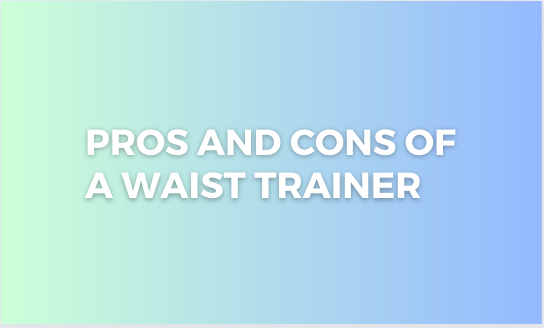Waist trainers have gained popularity as a means to achieve a slim waist and an hourglass figure. However, like any product, they come with both advantages and disadvantages. In the following list, we present 20 pros and 20 cons of using a waist trainer to help you make an informed decision.
Pros:
- Instant waist slimming: Waist trainers can provide immediate waist reduction and give the appearance of a smaller waistline.
- Posture improvement: They can help improve posture by providing support to the back and core muscles.
- Enhanced self-confidence: Wearing a waist trainer can boost confidence by accentuating curves and creating a more defined waist.
- Apparel versatility: With a smaller waist, it becomes easier to fit into a variety of clothing styles.
- Temporary inch loss: Waist trainers can temporarily reduce waist measurements, especially when worn consistently.
- Motivation for healthy habits: Using a waist trainer can serve as a motivation to maintain a healthy diet and exercise routine.
- Reduced overeating: The compression of a waist trainer may help control appetite and limit portion sizes.
- Back support: Waist trainers provide support to the lower back, reducing discomfort and promoting proper alignment.
- Postpartum recovery: They can aid in the recovery process after childbirth by providing gentle abdominal support.
- Hourglass figure enhancement: Waist trainers can create the illusion of an hourglass figure by cinching the waist and accentuating the hips and bust.
- Improved body awareness: Wearing a waist trainer can make individuals more conscious of their posture and body alignment.
- Enhanced thermal activity: Some waist trainers are designed to increase perspiration, potentially aiding in calorie burning during workouts.
- Invisible under clothing: Waist trainers can be discreetly worn under clothing without being visible.
- Temporary back pain relief: The added support can alleviate minor backaches and discomfort.
- Psychological effect: Waist trainers may provide individuals with a psychological boost, making them feel more motivated and confident.
- Posture correction: Over time, waist trainers can help train the body to maintain better posture.
- Waist training community: Engaging with others who use waist trainers can create a supportive community for shared experiences and tips.
- Increased body awareness: Waist trainers can help individuals become more aware of their body movements and posture throughout the day.
- Abdominal muscle support: They can provide support to the abdominal muscles during workouts, potentially reducing strain.
- Temporary waist shaping: Waist trainers can temporarily mold the waist into an hourglass shape when worn consistently.
Cons:
- Discomfort: Waist trainers can be uncomfortable, especially when worn for extended periods.
- Breathing restriction: Some individuals may experience restricted breathing or shallow breaths while wearing a waist trainer.
- Organ compression: Prolonged use of waist trainers may compress organs and potentially lead to digestive issues.
- Muscle weakness: Relying too heavily on a waist trainer can result in weakened core muscles.
- Dependency: Individuals may become dependent on waist trainers to achieve the desired waistline appearance.
- Skin irritation: Extended use of waist trainers can cause skin irritation, rashes, or chafing.
- Restricted movement: Waist trainers can limit mobility and range of motion in the midsection.
- Potential for bruising: If worn too tightly or for prolonged periods, waist trainers can cause bruising.
- False sense of weight loss: Waist trainers may create the illusion of weight loss due to temporary inch reduction, but this is not actual fat loss.
- Negative body image: Reliance on a waist trainer may contribute to an unhealthy body image and unrealistic beauty standards.
- Decreased core strength: Over time, waist trainers can weaken the core muscles responsible for maintaining posture and stability.
- Digestive issues: Waist trainers may interfere with digestion, leading to acid reflux, bloating, or constipation.
- Potential for rib discomfort: Tight waist trainers can cause discomfort or pain in the ribs.
- Water retention: Some individuals may experience water retention due to the pressure exerted by the waist trainer.
- Muscle atrophy: Excessive reliance on waist trainers can lead to muscle atrophy in the abdominal region.
- Negative long-term effects: Prolonged and excessive use of waist trainers may have long-term health consequences.
- Potential for injury: Waist trainers can increase the risk of injury during physical activities due to restricted movement.
- False sense of fitness: Waist trainers may create the illusion of a fit physique without actually improving cardiovascular fitness or muscle tone.
- Negative impact on organs: Prolonged use of waist trainers can potentially affect organ placement and function.
- Unrealistic expectations: Waist trainers may create unrealistic expectations of achieving permanent waist reduction without proper diet and exercise.
Pros
- Instant waist slimming
- Posture improvement
- Enhanced self-confidence
- Apparel versatility
- Temporary inch loss
- Motivation for healthy habits
- Reduced overeating
- Back support
- Postpartum recovery
- Hourglass figure enhancement
- Improved body awareness
- Enhanced thermal activity
- Invisible under clothing
- Temporary back pain relief
- Psychological effect
- Posture correction
- Waist training community
- Increased body awareness
- Abdominal muscle support
- Temporary waist shaping
Cons
- Discomfort
- Breathing restriction
- Organ compression
- Muscle weakness
- Dependency
- Skin irritation
- Restricted movement
- Potential for bruising
- False sense of weight loss
- Negative body image
- Decreased core strength
- Digestive issues
- Potential for rib discomfort
- Water retention
- Muscle atrophy
- Negative long-term effects
- Potential for injury
- False sense of fitness
- Negative impact on organs
- Unrealistic expectations


